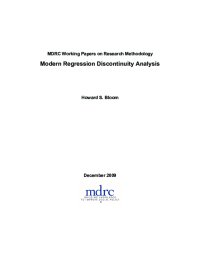Modern Regression Discontinuity Analysis
This paper provides a detailed discussion of the theory and practice of modern regression discontinuity (RD) analysis for estimating the effects of interventions or treatments. Part 1 briefly chronicles the history of regression discontinuity analysis and summarizes its past applications. Part 2 explains how in theory a regression discontinuity analysis can identify an average effect of treatment for a population and how different types of regression discontinuity analyses — “sharp” versus “fuzzy” — can identify average treatment effects for different conceptual subpopulations. Part 3 of the paper introduces graphical methods, parametric statistical methods, and nonparametric statistical methods for estimating treatment effects in practice from regression discontinuity data plus validation tests and robustness tests for assessing these estimates. Section 4 considers generalizing regression discontinuity findings and presents several different views on and approaches to the issue. Part 5 notes some important issues to pursue in future research about or applications of regression discontinuity analysis.






